When you purchase through links on our site , we may earn an affiliate commission . Here ’s how it works .
What do you call a runaway exomoon with delusions of planethood ? You call it a " ploonet , " of row .
scientist had previously proposed the endearing term " moonmoons " to describe lunar month that may orbit other synodic month in distant solar systems . Now , another team of researchers has coined the musical nickname " ploonet " for moons of elephantine major planet orbiting blistering stars ; under certain circumstances , these lunar month abandon those orbits , becoming satellites of the host star .

An artist’s illustration of a potentially habitable exomoon orbiting a giant planet in a distant solar system.
The former moonshine is then " unbound " and has an range like a planet ’s — ergo , a ploonet . [ Top 10 Amazing Moon fact ]
Ploonets — and all exomoons , for that matter — have yet to be observe . But ploonets may bring about light signatures that planet - hunting telescopes could identify , researchers reported in a unexampled work . Their finding were publish June 27 inthe preprint diary arXivand have not been peer - reviewed .
For the study , the scientists make computer framework to test scenario that might transmute a planet - orbiting moonshine into a star - orbiting ploonet . The researcher come up that if a synodic month is circling a type of exoplanet known as a " hot Jupiter " — a massive gas behemoth close to a star — the gravitative tower of state of war between star and planet could be powerful enough to wrest the moonshine from its world-wide orbit and send the aim circling around the star instead .

revolve a nearby lead would be stressful for a tiny ploonet ; during its transit , the ploonet ’s standard pressure could disappear and the world would turn a loss some of its mountain , creating a classifiable signature in the luminousness emitted from the star ’s neck of the woods , the study say . That ’s the signature that telescopes might be able-bodied to observe .
In fact , recent reflexion of mystical light discharge around far-off hot stars could be explained by the appearing , and draw - out deaths , of wayward ploonets , the report said .
Some ploonets could sustain their orbits for hundreds of meg of years . By accreting material fromthe disk of dust and gasaround its superstar , a ploonet could even build up up its organic structure until it eventually became a small-scale major planet , the discipline authors wrote .

However , most ploonets would in all likelihood be relatively short - hold up , the pretending showed . The bulk of the endearingly named objective disappear within a million years and never became planet ; instead , they disintegrated during collisions with their former legion planet , were bolt up by stars in enactment of " erratic cannibalism " or were eject from electron orbit into space , the researchers reported .
Originally published onLive scientific discipline .















